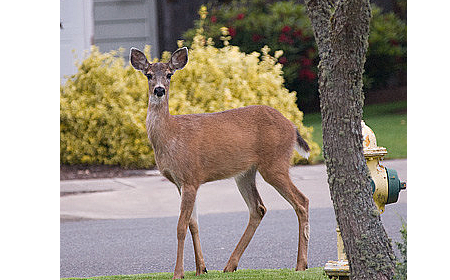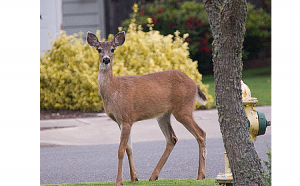
Drivers Advised to Look Out for Deer and Bears on Maryland Roads
 AAA Mid-Atlantic is reminding motorists to be alert for roaming deer as it is mating season. The mating season, also known as rut, typically runs from late Oct. through Nov in the fall, according to the Maryland Department of Natural Resources (DNR).
AAA Mid-Atlantic is reminding motorists to be alert for roaming deer as it is mating season. The mating season, also known as rut, typically runs from late Oct. through Nov in the fall, according to the Maryland Department of Natural Resources (DNR).
But that’s not all.
If you are driving in western Maryland, you should also be alert for black bears that are foraging for food, according to an AAA report.
While summer is the breeding season for bears, this the time of the year when the bears begin to den. Black bears are found primarily in Garrett, Allegany, Washington and Frederick counties with the highest populations in Garrett and Allegany counties.
According to an unofficial count maintained by the Cumberland Times-News, the number of bears killed in 2016 on Maryland roadways has risen to 57 with the most recent bear fatality on October 31 on U.S. Route 40 near Frostburg in Allegany County. Bear strikes by motor vehicles have averaged 55 per year over the last five years, and occur mostly at night when the bears are out feeding, according to Harry Spiker with the DNR black bear response team.
In Maryland, over 11,000 deer were estimated to have been killed by motor vehicles in 2015, according to the Maryland Department of Natural Resources. The highest number of collisions occurred in Montgomery County with 3,934 deer killed, followed by Howard County with an estimated 1,617 deer killed.
“A collision with a deer, or other animal, can put a serious dent in a vehicle, if not destroy it completely,” said Ragina Cooper Averella, government and public affairs manager for AAA Mid-Atlantic. “However, the true cost goes far beyond vehicle damage. Each year, motorists are injured, and sometimes killed, in these crashes.”
AAA Mid-Atlantic is urging motorists to be particularly cautious during the morning and evening commute, which tends to coincide with increased deer activity. The end of daylight saving time is adding to the challenge to avoid deer and other animals, as many drivers now encounter a darker commute home.
Also be alert when driving near wooded areas along local roadways.
“Most animal-vehicle collisions occur on two-lane roads bordered by natural habitat,” said Averella.
AAA Mid-Atlantic offers the following tips to help avoid potentially deadly and costly accidents involving all kinds of animals:
• Scan the road and shoulders ahead of you. Looking ahead helps provide enough reaction time if an animal is spotted.
• Deer seldom travel alone, so when there is one, there are usually more in the area. Bears tend to travel solo except for a mother and her cubs.
• Use high beam headlights if there’s no oncoming traffic. Wildlife may be spotted sooner when using high beams. This will give the driver time to slow down, move over or honk the horn to scare the animal away. High beams also help in spotting some animals’ reflective eyes.
• Be extra cautious at dawn and dusk. Most animals, especially deer, tend to be more active early in the morning and at dusk. Deer can also be spotted at night as late as midnight.
• Slow down and use extra caution when traveling through areas with a high and active wildlife population. Be aware of increased wildlife movement in some regions during certain times of year such as hunting or mating season. Also, be observant in areas where roads divide agricultural fields from forestland.
• Don’t swerve. Many serious crashes occur when drivers swerve to avoid hitting wildlife and hit another vehicle or lose control of their cars.
• If a collision is unavoidable, apply the brakes firmly and remain in your lane.
• Drivers should always wear a seat belt and remain awake, alert and sober.
• Do not try to move the animal. An injured animal might panic and seriously injure someone. Call police or animal control for assistance.
Steer clear of deer! Slow down around curves & use high beams when there is no oncoming traffic. #AAAInsurance pic.twitter.com/31rPOMpK8R
— AAA Mid-Atlantic (@AAAMidAtlantic) November 12, 2016

Engage us on Facebook
Follow us on Twitter
Tweets by @mymcmedia